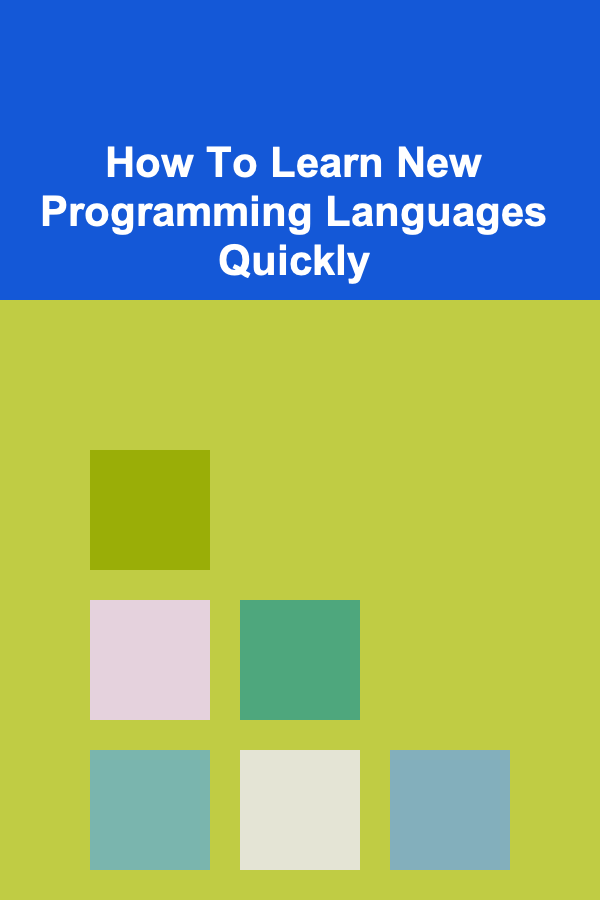
How To Learn New Programming Languages Quickly
ebook include PDF & Audio bundle (Micro Guide)
$12.99$11.99
Limited Time Offer! Order within the next:

Learning new programming languages can be an exciting and rewarding experience for developers. As technology evolves rapidly, the ability to learn new languages efficiently becomes a vital skill for staying competitive in the field. Whether you're transitioning from one programming language to another, or you're looking to expand your toolset, the process of learning new languages can often feel daunting.
However, with the right strategies, you can significantly shorten your learning curve and become proficient in new languages more quickly. This article explores effective methods and tips for learning programming languages swiftly and efficiently, with a focus on leveraging existing knowledge, understanding fundamental concepts, and practicing smart techniques.
Understand the Core Principles of Programming
Before diving into a new programming language, it's crucial to have a solid grasp of the core principles of programming. Most modern programming languages share fundamental concepts, including variables, data types, control structures (like loops and conditionals), functions, and object-oriented programming (OOP). Understanding these basics will make it much easier to transition from one language to another, as you'll see the similarities between them and be able to focus on the nuances of the new language.
Key Concepts to Master:
- Variables & Data Types: Most languages use variables to store data, but the syntax and available data types can differ. Learn how variables are declared and how to work with different types in each language.
- Control Structures: Familiarize yourself with the syntax for loops, conditionals, and error handling in the language you're learning.
- Functions: Functions or methods are key to organizing code. Understand how they are defined and used in the new language.
- Object-Oriented Programming (OOP): Many programming languages are object-oriented. Understand how classes, objects, inheritance, and polymorphism work.
By having a strong understanding of these core programming concepts, you'll be able to pick up any new language more quickly.
Learn the Syntax and Key Differences
Once you've mastered the basic principles, the next step is to dive into the syntax of the new programming language. Syntax is the set of rules that defines the structure of statements in a language. This includes things like how to declare variables, how to write functions, and how to handle loops and conditionals.
Steps to Learn Syntax:
- Identify Similarities: If you already know one programming language, look for the similarities between the syntax of the new language and your existing knowledge. For example, if you know JavaScript, learning Python will be easier because both are high-level, dynamically typed languages.
- Study Documentation: Familiarize yourself with the official documentation of the language. This is your ultimate source for understanding the proper syntax, best practices, and examples of how the language is used.
- Start with Small Examples: Write simple programs in the new language, such as "Hello World" programs, to get comfortable with its syntax. Try modifying these examples and experimenting with small code snippets to see how things work.
Common Syntax Differences:
- Indentation : Python, for example, uses indentation to define code blocks, whereas other languages like C or Java use curly braces
{}. - Variable Declaration: Some languages like Java require explicit variable type declarations, while others like JavaScript allow dynamic typing.
- Error Handling : The way errors are handled varies greatly between languages, with some using
try-catchblocks and others using error codes or exceptions.
Paying close attention to these differences helps speed up the process of familiarization with a new language.
Focus on Learning Through Practical Experience
The fastest way to learn a new programming language is to write code in it. The more you practice, the more comfortable you will become with the syntax, libraries, and debugging process. A great way to do this is by building small, functional projects or solving problems on coding platforms like LeetCode, HackerRank, or Codewars.
Effective Practice Strategies:
- Work on Small Projects: Start with small programs that you can complete quickly, such as a calculator or a to-do list application. Gradually increase the complexity of your projects.
- Solve Problems: Practice coding problems on online platforms. This helps reinforce syntax and develop your problem-solving skills.
- Replicate Existing Projects: Replicating projects or tutorials from scratch is a good way to gain experience with the language in real-world contexts.
By focusing on practical coding rather than theoretical knowledge, you'll internalize the syntax and concepts much more effectively.
Use Online Resources and Tutorials
The internet is packed with tutorials, forums, and documentation for virtually every programming language. Many of these resources offer step-by-step guides, video tutorials, and interactive coding challenges that can speed up the learning process. Some popular resources include:
- FreeCodeCamp: Offers free, comprehensive tutorials and exercises in various programming languages.
- Codecademy: Provides interactive lessons where you can write and test code within their platform.
- Udemy/Coursera: These platforms offer video tutorials on virtually any programming language, often taught by industry experts.
Tips for Maximizing Online Resources:
- Combine Theory with Practice: Don't just watch videos or read articles---actively write code alongside the tutorials. Try the examples and then modify them to explore new concepts.
- Join Developer Communities: Platforms like Stack Overflow, Reddit, and GitHub are excellent places to ask questions, share your code, and learn from others' experiences. Engaging with the community helps you solve real-world problems and gain new insights.
- Contribute to Open Source Projects: Once you feel confident, contributing to open-source projects can help solidify your skills and give you practical experience working with a new language.
Break Down Complex Topics into Manageable Chunks
Learning a new programming language can be overwhelming if you try to tackle everything at once. Instead, break down the language into smaller, more manageable chunks, and focus on mastering one area at a time. This allows you to stay focused and avoid burnout.
Suggested Learning Breakdown:
- Syntax & Basic Constructs: Understand how the language structures code (variables, data types, control flow).
- Functions and Methods: Learn how to define and call functions, as well as pass parameters.
- Libraries and Frameworks: Explore the most commonly used libraries and frameworks that are typically used with the language (e.g., React for JavaScript, NumPy for Python).
- Advanced Concepts: Tackle more complex topics like asynchronous programming, concurrency, and design patterns once you're comfortable with the basics.
By organizing your learning in this way, you'll avoid feeling overwhelmed and gain deeper understanding step by step.
Learn from Mistakes and Debug Efficiently
Making mistakes is an inevitable part of the learning process, especially when you're working with a new language. Instead of getting frustrated, try to view these mistakes as learning opportunities. Debugging effectively is also an essential skill that helps you develop your understanding of how the language works.
Tips for Debugging:
- Use a Debugger: Most integrated development environments (IDEs) have built-in debuggers. Use them to step through your code and identify errors.
- Print Statements: In many cases, using print statements can help track down issues by showing the state of variables at different points in your program.
- Understand Error Messages: When an error occurs, read the message carefully to understand what went wrong. Learning how to interpret error messages is key to fixing problems quickly.
The more you debug, the more you'll understand the intricacies of the language and become proficient in solving common issues.
Stay Consistent and Keep a Growth Mindset
Learning any new skill, including programming, requires consistency and perseverance. Don't expect to become proficient in a new language overnight. Set achievable goals, maintain a steady pace, and celebrate small victories along the way.
Tips for Staying Consistent:
- Set Daily Goals: Dedicate a set amount of time each day to learning or practicing programming. Even 30 minutes a day can lead to significant progress over time.
- Track Progress: Keep a learning journal or log of the languages you've learned and the projects you've completed. This will help you track your progress and stay motivated.
- Be Patient: Learning a new language can take time, and it's okay to not understand everything immediately. Embrace the process and don't be afraid to ask questions or seek help when needed.
By maintaining a growth mindset and staying consistent in your efforts, you'll make steady progress toward mastering any new programming language.
Immerse Yourself in the Language
One of the fastest ways to learn any language---whether spoken or programming---is immersion. Immerse yourself in the ecosystem of the language you're learning by reading books, watching tutorials, and collaborating with others who are proficient in it. The more exposure you have to the language, the faster you'll learn.
Ways to Immerse Yourself:
- Read Source Code: Open-source projects on GitHub are an excellent resource for seeing how experienced developers write code in the language you're learning.
- Attend Meetups: Join local or virtual coding meetups, workshops, or hackathons to connect with other learners and experienced developers.
- Watch Conference Talks: Many tech conferences share videos of their talks online. Watching these presentations can expose you to best practices and cutting-edge techniques in the language.
By surrounding yourself with the language in various forms, you'll accelerate your learning process.
Conclusion
Learning a new programming language quickly is entirely possible with the right mindset, resources, and strategies. By leveraging your existing knowledge, focusing on practical experience, breaking down complex topics, and utilizing online resources, you can become proficient in any language. Most importantly, stay consistent, be patient with yourself, and enjoy the process of learning. With each new language you master, you'll open up new doors to exciting opportunities and challenges in your development career.

How to Create a Household Budget That Works
Read More
How to Incorporate Holiday Decor Into Your Home Office
Read More
How to Make Smart Financial Decisions as a Small Business Owner
Read More
How To Master Pinterest Marketing for Small Businesses
Read More
How to Develop a Workout Routine for Beginners
Read More
Investing in Green Technologies: A Comprehensive Guide
Read MoreOther Products

How to Create a Household Budget That Works
Read More
How to Incorporate Holiday Decor Into Your Home Office
Read More
How to Make Smart Financial Decisions as a Small Business Owner
Read More
How To Master Pinterest Marketing for Small Businesses
Read More
How to Develop a Workout Routine for Beginners
Read More